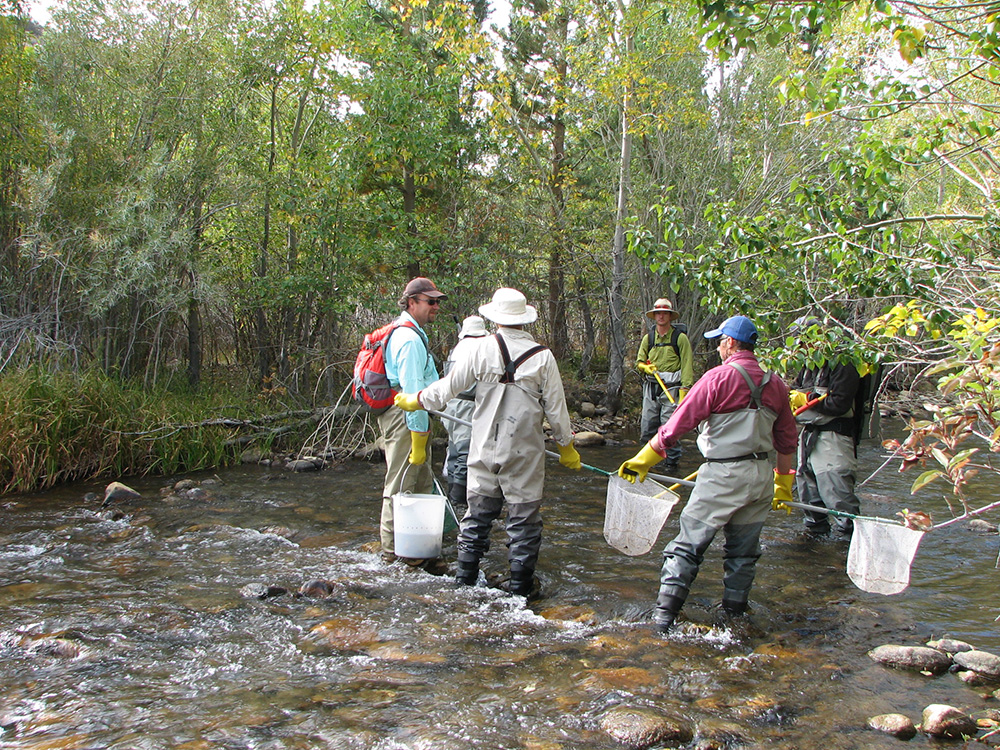
This post was written by Lisa Cutting, 2002-2020 Eastern Sierra Policy Director, 2000-2001 Environmental Resource Coordinator, and 1999 Mono Lake Intern.
The 2017 spring snowmelt runoff was over 200% of average. It was also the single largest peak flow event since the stream restoration ordered by the California State Water Resources Control Board began in 1998 (see Fall 2017 Mono Lake Newsletter).
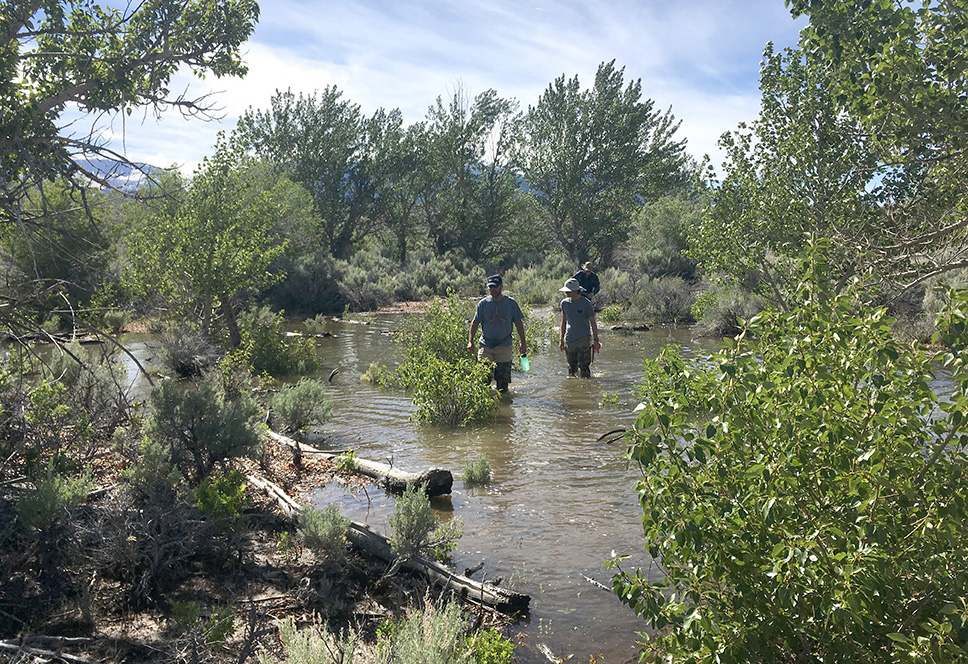
Now, almost two years later, conversations and field observations continue to reflect on what is technically called an “Extreme-Wet” year type, validating the principles adopted by the State Water Board and restoration parties over 20 years ago.
The State Water Board appointed two independent experts, the Stream Scientists, to study Mono Lake’s tributary streams and inform and guide restoration. Dr. Bill Trush’s expertise is in geomorphology and stream ecology, and Ross Taylor focuses on fisheries. Together they are the official scientific experts who monitor physical creek structure, habitat, and trout populations—assessing ecosystem health and making official restoration recommendations. They provide the detailed information needed to achieve full stream ecosystem recovery. As part of the State Water Board’s plan, in 2010 Trush and Taylor and their team submitted the Synthesis of Instream Flow Recommendations report based on 12 years of intensive monitoring. The Synthesis Report made recommendations for an improved pattern of streamflow releases on Rush, Lee Vining, Parker, and Walker creeks to improve restoration outcomes. All parties, including the Los Angeles Department of Water & Power, agreed to adopt these flows when signing the Mono Basin Stream Restoration Agreement in 2013—with the intention that the Agreement components would be included in a revised water license issued by the State Water Board.
The restoration principles that have been guiding the stream restoration program for decades include mimicking physical and ecological processes created by the natural hydrograph as closely as possible, providing the full range of flow patterns, and letting the stream restore itself. 2017 confirmed these principles are working and are the key to successful restoration for the future.
We thought Newsletter readers would like to hear directly from the Stream Scientists to get a sense of their field observations from the past two years, insights on what the 2017 flood hydrograph accomplished, and an overall sense of the status of restoration.
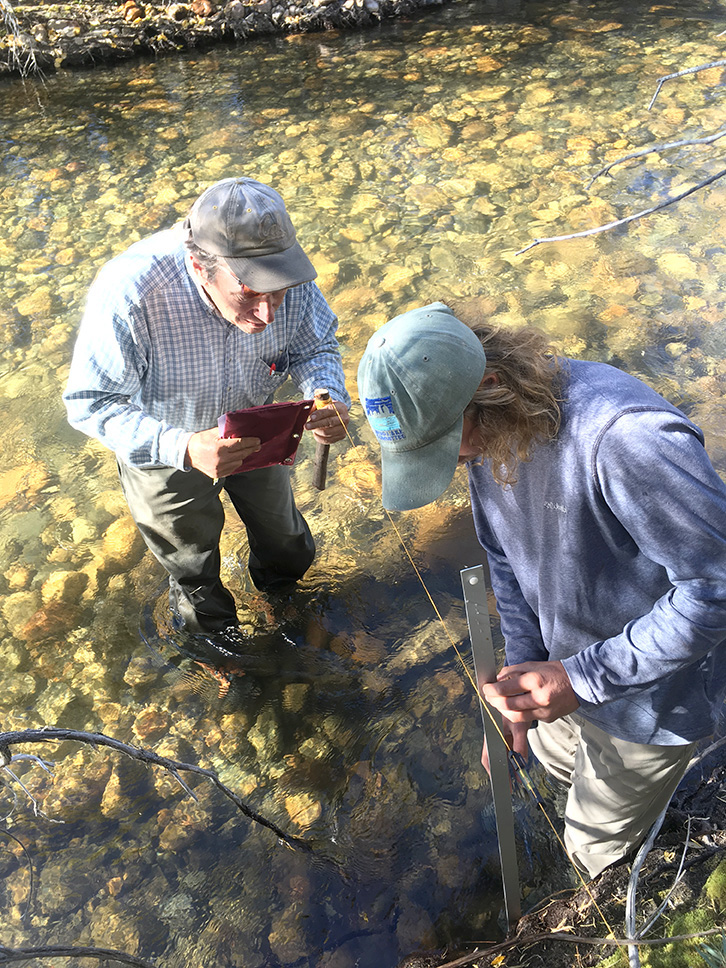
Lisa Cutting: Your report to the State Water Resources Control Board calls for higher springtime peak flows than are currently required. What are the benefits of these higher peak flows, and what are the benefits of a springtime peak flow like what we saw in 2017?
Bill Trush: Extreme-Wet year-type peak floods occur infrequently, yet these events are extremely important geomorphically, and consequently, important ecologically. They mobilize and transport bedload and fine sediment, create or improve pool habitat, scour undercut banks, deposit fine sediment onto contemporary floodplains benefiting riparian vegetation, and create new floodplains. Groundwater recharge also occurs across more of the floodplains during wetter-year runoffs.
Ross Taylor: The recommended peak flow for an Extreme-Wet year type is a minimum flow—we knew that in some years snowmelt runoff would likely cause peaks in excess of the recommended minimums.
In the Mono Basin, wetter year types like 2017 also mean that Grant Lake Reservoir is likely full of cooler water all summer, which is extremely important for brown trout growth and overall health of the trout population downstream. During the five drought years, we documented stressful summer thermal conditions for trout in Rush Creek downstream of Grant and population decreases upwards of 90%. The trout we did sample typically exhibited poor condition factors (an analysis of body weight versus length).
Cutting: Years like 2017 get all the press, but those are the outliers, not the norm. Are Extreme-Wet year-type spring flows more important than others? Obviously, the system is not going to get big year events every year, so how do the other runoff year types factor into the health of the system?
Trush: Whenever we think of snowmelt peak floods as a physical process, we have to consider the four primary characteristics that come into play: the magnitude, duration, frequency, and timing of each event. Each annual peak flow (i.e., whether a 1.5-year flood, a 5-year flood, etc.) offers a unique combination of these four primary characteristics that creates unique geomorphic and ecological outcomes.
Broadly, healthy stream ecosystems thrive as a balancing act between opposing tendencies. Small flood hydrographs encourage riparian encroachment into the mainstem channel, whereas bigger floods tend to scour streamside riparian vegetation. Small and big are important for floodplain connectivity and for creating/sustaining fish and macrobenthic invertebrate habitat complexity. All flow regimes address specific ecological needs and are essential in maintaining a stream ecosystem’s capacity for self-renewal.
Taylor: Yes, the infrequent large peak flows are extremely important for the geomorphic work performed. Conversely, from the fisheries perspective, we made a huge leap in recommending lower than currently-released flows during the wintertime. I think the conservation groups initially thought we had lost our minds and were giving LADWP access to more water. However, our instream flow studies, our radio telemetry study, and the examination of unregulated hydrographs from Buckeye Creek near Bridgeport convinced us that lower winter flows were more “natural” on the east slope of the Sierra and that lower winter flows also created more slow-velocity pool habitat for overwintering brown trout. We also showed that lower winter flows would result in more water being held back in Grant Lake Reservoir and that a higher reservoir level going into the following spring/summer could provide more favorable summer thermal regimes for trout.
Below-average water years affect the summer water temperatures in Rush Creek below Grant and often create stressful conditions from daily high peak temperatures, high daily average temperatures, and high diurnal fluctuations. Summer water temperature monitoring has documented that LADWP’s facilities (Grant Lake Reservoir and the Mono Gate One Return Ditch) add a thermal load to Rush Creek, especially during below-average water years.
Cutting: What were your first impressions when you returned to the Mono Basin in 2017 and saw the creeks?
Trush: The Extreme-Wet year-type flows may not be as “extreme” as some might want to believe. Bedload transport increases sharply in these infrequent hydrological events. In 2018, we surveyed annual peak flow elevations for 2017 and 2018 in the mainstem in lower Rush. The 2017 runoff fluctuated approximately 1.5 to 2.0 feet higher in alluvial mainstem reaches than the not-quite bankfull 2018 “Normal” year-type peak flow. We expected that a particularly overly-tight, right bank meander bend, several meanders upstream of the bottomlands, was due an adjustment (meaning it was likely to be cut off). Lateral scour into the right bank eight-foot-high terrace was significant, leaving behind a newly formed, broad, left bank gravel/cobble bar. The 2017 peak flows set the stage for a newly-evolving, contemporary floodplain that will grow cottonwoods and willows, provide a depositional surface for finer bedload and suspended load, and offer complex off -channel habitat.
Taylor: The Rush and Lee Vining creek channels looked fairly similar—there was some noticeable bank scour and filling of some pools and creation of new pools within our annual sampling sections, but there was not an overall impression of radical change or negative impacts from 2017.
I was pleased to see that the Mono Gate One Return Ditch had experienced a good “flush” and that the beds of elodea looked healthier than they had during the five drought years when they were smothered in fine sediment.
I had expected that the brown trout population in Rush Creek would respond positively to the high flows and cooler summer water temperatures with a modest increase in numbers of fish and higher growth rates. My expectation of increased fish numbers was met, and growth rates exceeded expectations. In our upper Rush monitoring section the population estimate of Age-0 fish tripled from the previous year and the numbers of older fish experienced a modest increase. Recaptures of previously tagged fish documented the fastest growth rates we’ve seen of brown trout.
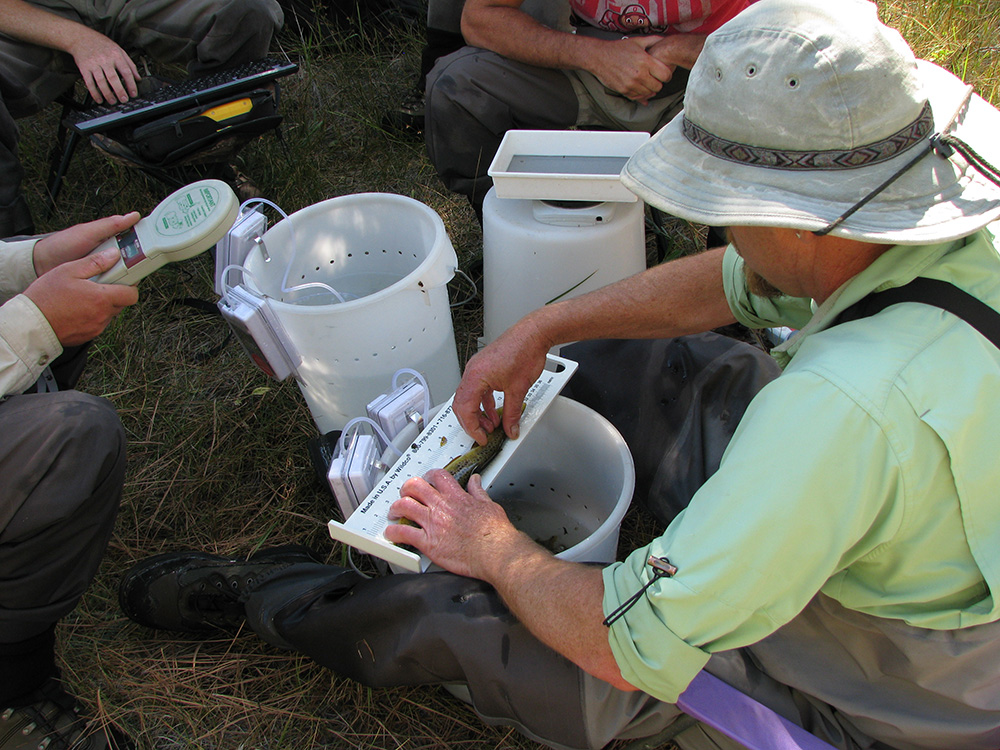
Cutting: Can you tell us about a favorite moment, sight, or memory from your field time in 2017?
Trush: Winding tracks recently left (maybe just hours before) by a Great Blue Heron exploring a newly created side channel reminded me how “nature” quickly adapts to and relies on change.
Taylor: My favorite memory from the 2017 field season was the recapture of a large, previously tagged brown trout. When we scanned the fish and saw the tag number, I immediately knew it was from our original batch of tags implanted in fish back in 2009—I confirmed it was a trout tagged in 2009 that we recaptured in 2010, 2013, 2014, and 2017. The fish was at least 11 or 12 years old and had survived the drought. It was 15.5 inches long and weighed 1.1 pounds when tagged in 2009 and was 25 inches long and 5.5 pounds when caught in 2017.
Cutting: 2018’s Normal year-type runoff allowed easier access for stream monitoring because water levels were lower than 2017. What struck you when you started to explore the creeks 2018? What was the biggest impact to the restoration process in your respective areas of expertise?
Taylor: What struck me the most was the resiliency of the brown trout population in Rush Creek and the fish’s ability to quickly bounce back from the five-year drought. Although 2018 was an average runoff year, water levels in Grant Lake Reservoir remained high throughout the summer, so lower Rush Creek experienced cooler water temperatures, and the brown trout population responded with increased recruitment of Age-0 fish and the older fish continued to exhibit good growth rates. Cooler water and peak flows of around 380 cubic feet per second through the Mono Gate One Return Ditch in 2018 allowed the beds of elodea to continue to recover from the drought. When healthy, this aquatic vegetation grows long thick mats that float on the surface, creating excellent overhead cover for trout and extensive surface area for algae colonization that then provides abundant food for aquatic invertebrates, thus abundant forage for trout.
Trush: Several come to mind. The geomorphic role of beavers really struck me—they engineered dams using live willows as surrogate “concrete reinforcement rods” for anchoring their dams that stymied removal by the 2017 peak flood. That was impressive.
Intensive cottonwood and willow seedling establishment in early October 2018 was the greatest I’ve witnessed in 25 years as a Mono Basin Stream Scientist. Other highlights include: construction of “meaty” vertical logjams; subtle accretion of fine sediment onto floodplains; diversification/amplification of channel margin habitats such as side channels with deep alcoves; and the rising importance of maturing woody vegetation in stabilizing, yet still promoting, a dynamic channel morphology.
Cutting: Looking into the future say, ten to 20 years from now, what on-the-ground change or processes in action would you like to be seeing?
Taylor: The biggest unknown will be the effects of climate change on the hydrologic patterns in the Eastern Sierra and how these altered patterns of snow, rain, and snowmelt will affect the Mono Basin. The fisheries perspective has always been tricky because there were no trout native to Mono Basin streams, let alone brown trout, a native to the European continent. Will there be viable, self-sustaining trout populations in Rush and Lee Vining creeks? I expect the answer will be “yes,” as long as streamflow patterns continue to mimic unimpaired flows as closely as possible and provide the ecological functions we deemed important in the Synthesis Report.
Having a more mature riparian canopy of cottonwoods will assist in alleviating summer water temperature concerns. The past 20 years of fisheries monitoring have shown that the trout populations will fluctuate with year type and that drier years will be unfavorable. Ultimately, the health of the creeks and implementation of the springtime peak flows provide Mono Lake the opportunity to refill to the ecologically healthy level established by the State Water Board.
Trush: I’d like to see a greater role of riparian vegetation influencing alluvial channel dynamics, particularly by maturing cottonwoods (especially those closest to the mainstem channel) and Jeffrey pines (if beavers allow).
I’d also like more extensive floodplain reconstruction and subsequent rebuilding and maintenance through the interplay of Extreme-wet through above Normal snowmelt hydrographs.
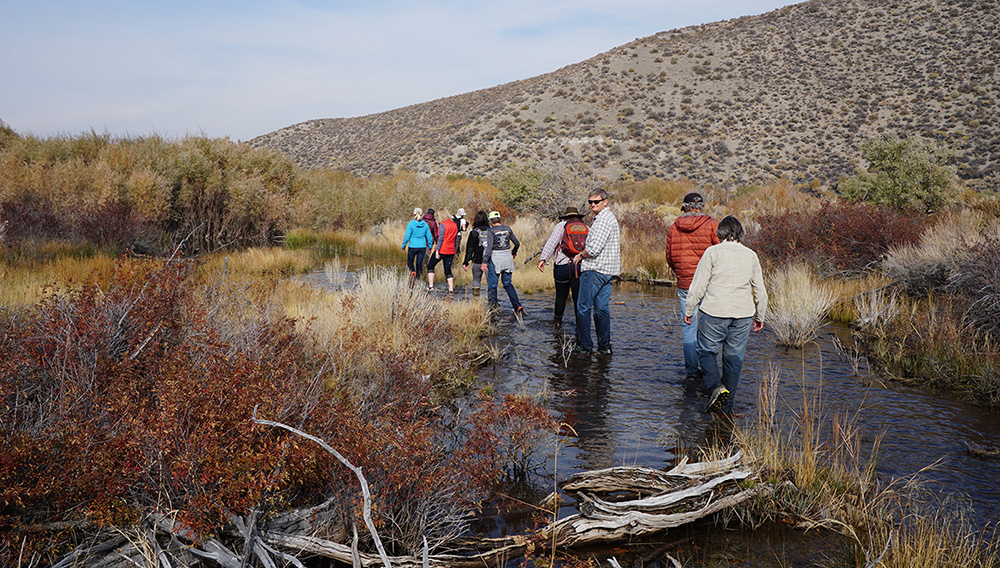
Cutting: People often ask us “When will restoration be done, completed, or finished?” What’s your perspective on that question?
Trush: The term “restoration” should be considered a self-sustaining verb rather than an endpoint noun. Our Synthesis Report flow recommendations to the State Water Board included flow releases designed as natural hydrographs to perpetuate Lee Vining and Rush creeks’ ongoing capacity for self-renewal.
Taylor: Never! As long as there are competing needs (water export and power generation) for the finite amount of water in Mono Basin streams, there will be human-induced stressors on the systems that will impede or confound restoration and recovery. Our recommended springtime peak flows will allow the streams to mimic nature as closely as possible, while some water is exported by LADWP. The peak flows were also intended to create a stream ecosystem that is resilient to varying year types, where recovery from stressors is possible when subsequent “good” years occur following “bad” years.
Finally, it bears remembering that the creek channels are still adjusting to the rapid (geologically-speaking) drop of Mono Lake’s elevation from LADWP’s post-1941 exports. The 45-foot drop in lake level was the catalyst for dramatic channel adjustments and impacts that are still in play today and will still be in play for many decades to come.
Lisa Cutting is the Committee’s Associate Policy Director. Twenty years of stream restoration has forever shaped her understanding of her favorite place to be—knee-deep in cold, clear, flowing water—fly rod in hand or not.
This post was also published as an article in the Winter & Spring 2019 Mono Lake Newsletter (pages 4, 5, 24, and 25).

